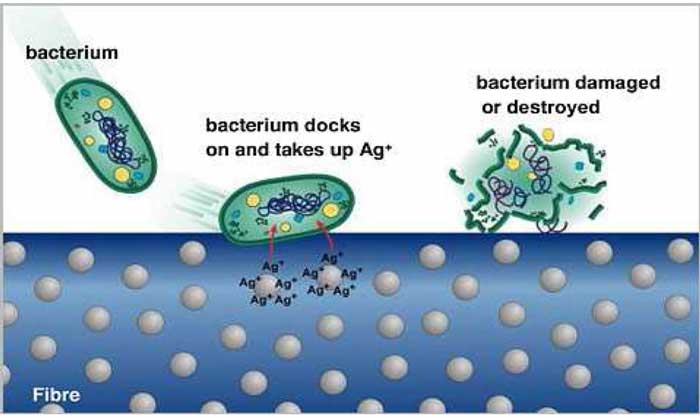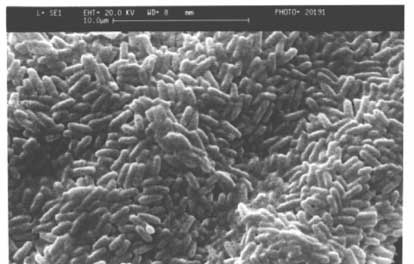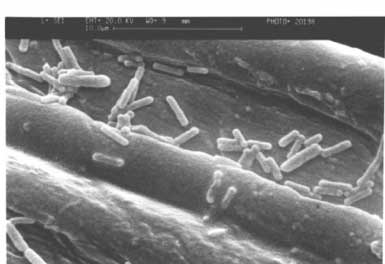Introduction:
The scope and usefulness of bio-engineered products are constantly increasing. Clothing is an ideal medium to implant mobile bio-environments. Niche applications for bio-active fabrics exist in the medical and defense industries – e.g. drug producing bandages or protective clothing with highly sensitive cellular sensors – but bio-fabrics may form the basis of a whole new line of commercial products as well: fabrics that literally eat odors with genetically engineered bacteria, self cleaning fabrics and fabrics that continually regenerate water and dust repellents.
Clothing is an obvious habitat for biological micro-machines and is specifically designed to provide a comfortable environment for living cells. These materials are generally bio-friendly (non-toxic to cells); and sources of heat, moisture and even nutrients for cellular micro-devices are all readily available from the human body.
There are many obvious applications that a clothing based bioreactor might be able to accomplish. The control of odors in clothes and shoes could be accomplished by secretion of deodorizers of by the bacterial digestion of odor producing proteins. Imbedded bacteria can replenish the water repellent coatings found on jackets or shirts, or bacteria’s can be introduced which digest oil and protein continuously, thus making self- cleaning mechanism for entire lifecycle of the garment.
Bio-active textiles have thus carved out a niche for itself both in the market and on the research field.
2. Organic and Inorganic Additives
Biguadine, isothiazolinon, organo silicon ammonium, permethrine, phenols, etc., are typically incorporated:
- At the finishing level (either at the yam, fabric or garment levels) by exhaustion, Padding, coating or foaming,
- Can be incorporated in the spinning solution with “wet” spun fibres
- Or with a spin finish (i.e. after the extrusion).
Organic substances are difficult to use with synthetic fibres such as PES and PA due to their heat resistance limitations. In this case inorganic agents, such as zeolites or ceramic substrates containing metallic ions (e.g. Cu, Ag or Zn) are currently mixed to the melt polymer stream,
3. Natural additives
Numerous antimicrobial textile materials are being developed by means of a variety of active agents which include synthetic antimicrobial agents such as triclosan, metal and their salts, phenols, quaternary ammonium compounds, and organometallics. Although synthetic antimicrobial agents effectively inhibit the growth of microbes, most of them are toxic, can cause adverse effects on human health, and have environmental issues. So research is being done on natural additives.
Natural antimicrobial compounds derived from various plants such as neem, tea tree, azuki beans, aloe vera, tulsi leaves (Ocimum sanctum), clove oil, pomegranate rind, turmeric, eucalyptus oil, onion skin, and pulp extracts, are applied on textiles to impart anti- microbial properties. Chitosan derived from chitin, a polysaccharide found in the shells of crustaceans and insects, in yeast cells or in fungi walls and even in certain algae Bioneem, an oil seed of the Indian neem tree, seaweed, etc.
4. Alternative Processes
Alternative processes to incorporate “Bio-active” agents are the following through microencapsulation: the process, which is at a trial stage, up to now only provides limited washing resistance or by using the grafting technology. Synthetic fibres could finally be covered/coated with inorganic additives such as silver and copper sulphide. The total market of “Bio-active” textiles is split into two main categories:
- Bio-active Finishes: textile products such as yams, fabrics and garments that are treated with an (organic) additive,
- Bio-active Inherent fibres: Fibres, which are incorporated in the spinning solution or mixed to the melt polymer stream.
5. Bioactive Textile Dressing Materials from Dibutyrylchitin.
Dibutyrylchitin (DBC) is an ester derivative of natural polysaccharide – chitin. DBC is obtained by reaction of chitin with butyric anhydride in the presence of a catalyst. The production methods of DBC were elaborated, optimized and DBC as raw material will be soon available on the market. DBC is easily soluble in common organic solvents and has film- and fibre forming properties. Such characteristic allows obtaining classical fibres from the polymer solutions. DBC is also a raw material for manufacturing yarn and for a broad range of textile dressing materials. Fibres with good mechanical properties were obtained by an optimized spinning process from the DBC solutions.
The excellent biomedical properties of the DBC were confirmed by different experimental results which proved that DBC is a biocompatible and biodegradable polymer and stimulates regeneration of damaged tissues. Tests of these DBC dressing materials under clinical conditions were done and proved the excellent results of DBC-based dressing materials for the ordered healing of tissues and wounds. The DBC dressing materials accelerate the healing of the wound and are biodegraded during the healing process. From the clinical tests, it was clearly observed that the DBC dressing materials were absorbed into the fresh tissue formed during the healing process of the wounds. DBC and DBC-based dressing materials are good bioactive textile materials for wound healing and for understanding the biological properties of chitin derivatives. The obtained results proved the importance of the O-substitution of the hydroxyl groups present in chitin, not only for the solubility of the derivatives and the mechanical properties of the produced fibres, but still more important for the biological properties of these ester derivatives of chitin containing butyricacid. This development creates a link between textile products, based on material properties, and human health, based on the biological properties of the basic material.
6. “Bactericidal” versus “Bacteriostatic”
From the point of view of their activity, anti-bacterial (or anti-fungal or anti dust mite) Substances could be split into two main categories:
- Substances that kill or “significantly” reduce the population of bacteria called “bactericidal”
- Whereas substances that only suppress/reduce the bacteria growth are called “bacteriostatic”. These products should in principle not decrease the bacterial level lower than that which is normally present on the skin.
In practice it is difficult to separate pure “bactericidal” from “bacteriostatic”, as there is no universally accepted definition of what constitutes “significant reduction” in the bacterial colony. In addition these activities very much depend on the particular strains of micro-organisms involved, as well as on the actual concentration of the antibacterial used.
“Migrating” versus “Non-migrating” Additives
A further distinction could be made between various additives based on their main working mechanism:
- Migrating (leaching) Additives: the additive gradually migrates out from the fibre or the fabric to a solvent external medium and comes in contact with the micro-organisms. The majority of organic compounds are of this type,
- Non-migrating (non-leaching) Additives: the additive agent is bonded to the textile and does not dissolve out. This is the case, for example, for organo functional silanes.
In the case of inorganic additives, such as zeolites with metal ions, the anti-bacterial mechanism involves the movement of the ions to the microorganism cell. The concentration of metal ions, which flow out, is, nevertheless, very limited (in the order of ppm). One of the main advantages claimed for non-migrating additives is that they avoid the possible risk of creating adaptive micro-organism.
8. Antimicrobial Agent Based On Silver
Antimicrobial agent based on silver is firmly anchored in the fibre polymer. This additive exercises a permanent antimicrobial effect and is not affected by either washing or usage. In the process it functions on the surface of the fibre and does not migrate into the surrounding atmosphere. It has been shown that Trevira Bioactive causes no change to the skin flora and is therefore compatible with the skin.

When bacteria come into direct contact with the textile, they are damaged by the silver ions, which prevents them multiplying.

Silver Bio Active Fiber.
Another example of bioactive textiles is Neemshield, an innovative ecofriendly patented technology for making antimicrobial textiles developed by the Textile Department, IIT Delhi

Untreated

Treated with NeemShield (Reduced Bacterial Adherence on treated Cotton Fabrics As seen under Scanning Electron Microscope)
Some benefits of Neemshield as given by IIT, Delhi are easy application, non allergic and skin friendly, energy saving, semi durable to washing, active against wide range of bacteria.
9. Application areas:
Work wear sector:
- Work and protective wear • Uniforms
Functional underwear and sportswear sector:
- Sport and fitness wear
- Functional underwear
- Outdoor wear
- Socks, hosiery
Home and contract textiles sector:
- Decorative textiles
- Upholstery fabrics
- Bedding textiles
Home Textiles:
- Bed linen
- Towels• Mattress covers
- Fill material for pillows and duvets
Other applications:
- Incontinence underlay’s and underwear
- Bandages
- Support corsets and hosiery
- Cleaning textiles
- Slipcovers
- Inner linings and insoles for shoes
10. The Future Market for “Bio-Active” Textiles
“Bio-active” textiles belong to the so-called “Functional” range of products, i.e. to textiles which, in addition to their basic functions, claim to take care of the health and hygiene of the consumer contributing to his/her well-being.
Positive Elements: Main positive elements are the following:
- The consumer is expected to become more and more aware of hygiene in everyday life so that “Bio-active” textile are generally seen as a way to provide additional direct benefits to the consumer,
- “Bio-active” textiles provide the consumer with the possibility to keep the product “fresh and clean” (as it was when it was purchased) for a longer period of time.
- In the “healthcare” sector, the growing number of people affected by allergies and the increasing awareness of this potential danger for children provides significant growth potential for “anti-dust mite” products.
- The necessity to prevent increasing costs as a result of contamination in hospitals and clinics should lead to a growing demand for “anti-bacterial” textiles. The requirement of increased hygiene is also likely to affect all activities which are related to the food/drink processing industries and services and other sectors requiring aseptic conditions.
- The possibility to supply “Bio-active” textiles providing additional functions further increases the potential market.
Negative elements: The main element limiting the potential growth of “Bio-active” textiles is the lack of legislation providing guarantees and security in the marketplace. It is expected that the Biocidal Products Directive will provide a pan-European harmonization allowing clarification of the situation. This should also stimulate the market.
Other negative elements are the following:
- The negative attitude of scientists and dermatology specialists towards products which may affect the equilibrium of germs resident on the skin.
- The careful attitude of several large retailers and international brands concerning the content of chemical additives and generally the negative image of “chemicals” additives, in particular in countries such as Germany, UK and Scandinavia.
- The confusion prevailing in the claims promoted by suppliers, which is a direct consequence of the above-mentioned lack of legislation.
- The general fear that the growing usage of anti-bacterial additives in an increasing number of goods, including textiles, may have a negative impact on the health of the consumer and on the environment in the long term.
- The continuing delocalization of the European textile activity, so that an increasing share of “Bio-active” products will be imported.
11. Requirements for “Bio-active” textiles:
- Safety: The product should be safe for the consumer and for the environment.
- Durability: “Bio-active” properties should remain effective during the (variable) life span of the product
- Easy to apply: The product should be easy to use in the whole textile pipeline.
In addition, the product should continue to satisfy the typical textile qualities and requirement and should be available at a competitive cost. The described fabrics have numerous medical uses such as surgeon’s gowns, medical drapes, isolation gowns, instrument wraps etc.
12. Conclusion
The total production of “Bio-active” textiles is expected to benefit from an annual compound growth rate of 12%, with anti-dustmite properties providing a slightly higher potential growth. The number and effectiveness of these lining devices is rapidly expanding. The fields of applications of bio active textiles are expected to increase and reach the common man in the near future.
 By: Anshu Chauhan1,a, Sachin Chauhan2,b
By: Anshu Chauhan1,a, Sachin Chauhan2,b
1 M.S. – Wuhan Textile University, China; B Tech- TIT&S Bhiwani (Haryana); Merchandising Manager (Pinnium Brands)
2M.S. – Wuhan Textile University, China B Tech -TIT&S Bhiwani (Haryana); Asst Manager, National Textile Corporation, Delhi



















